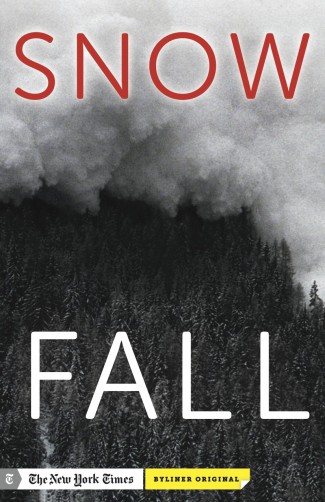BENEATH THE SNOW: John Branch answers questions about ‘Snow Fall,’ his new Byliner e-book

As skiers take to the slopes in search of some quality powder in the new year, Byliner and The New York Times have released a new e-book by John Branch that depicts the harrowing story of a treacherous avalanche in the mountainous backcountry of Washington State. Snow Fall: The Avalanche at Tunnel Creek was released as a special multimedia project by The New York Times and co-published by Byliner, a digital book publisher.
The journalism piece features interviews with survivors, a meticulous retelling of what happened on the slope and the unfortunate steps that led to the rushing wave of snow.
Recently, Hollywood Soapbox exchanged emails with Branch about his new e-book. Here’s a behind-the-scenes Q&A on how the author approached the avalanche story.
How did you first find out about the story of this deadly avalanche?
Another reporter actually wrote a next-day story about it in February, broadly discussing what seemed to be a rare rash of avalanches last winter, many of them killing well-known backcountry experts. At the time, the Tunnel Creek avalanche was the latest example. The Times published that story on the front page. But Sports Editor Joe Sexton recognized that there could be something more to be done, and he enlisted me to examine that particular avalanche more closely.
For readers, could you describe the reporting process? What was the experience like talking with the survivors?
I first tried to research all I could about the avalanche, including the names of those who were part of the group – something that previous stories and even police reports did not compile. I wrote an long email to a few of the people, explaining that I would like to do a long-range story about the avalanche, and avalanches in general. I hoped that they would be willing to share their memories and expertise. I quickly received a few replies, which was wonderful. One by one, over several weeks, I tracked down various members of the group. In the end, I was fortunate that all of them, plus the families of those left behind, the first responders, the forecaster and Stevens Pass officials were all willing to cooperate. I have a huge amount of respect and appreciation for them. I spoke to most of the survivors several times, usually on the phone and then in person. As you might expect, the conversations are not always easy. I’m a stranger, asking people to tell me about the moments surrounding the deaths of husbands, sons and friends. Not a lot of those conversations were tear-free.
This new relationship between Byliner and The New York Times is an interesting partnership. Do you feel this could help bring more readers to the uneasy world of print journalism?
I’m proud that “Snow Fall” became the first in what I hope is a long line of long-form stories shared between The New York Times and Byliner. I’m sure there are a lot of long-form readers out there who no longer see newspapers as the source of great narrative content. So many papers have leaned the other way, hoping to attract readers with smaller bites of information. I hope these stories with Byliner will demonstrate that The New York Times can be a lot of things to a lot of people.
The newspaper story is constructed to tell the story of 16 people on one day. It ends on the mountain in the aftermath of the avalanche. The e-book continues the story in a sort of extended epilogue, updating people about the lives left behind. I spent a lot of time working on this story through the summer, in the months following the avalanche. That shows through in the e-book in ways that were not possible in the newspaper story.
What are the necessary components that warrant a piece of long-form journalism (as opposed to a standard piece that might come in under 1,000 words)?
That’s a great question, and there’s no easy answer. Must it have a broad impact on the lives of readers? Can it be merely a tale? In this case, we recognized early on that this could be a riveting tale, and 1,000 words would not do it justice. What made this avalanche so rare is that there were 16 people there, experiencing it in different ways – some were caught in it, some watched it zoom past, some saw it slide from above, and some had no idea it happened until they found a pile at the bottom. Plus, there were loved ones and rescuers a few miles away. I wanted to weave those stories together. It was kind of like sorting a bowl of spaghetti noodles. I needed a little room to make sense of it all.
Are you a skier yourself? Does this tale serve as a cautionary one?
I grew up in Colorado and was a decent skier. I’m not sure how much that helped inform the story, but I think it gave me an intangible ease in understanding the mindset of the people involved, and helped in a practical way to understand the logistics on a ski mountain. I know what it’s like to stand in lift lines, to feel the cold as you head up the mountain, to sense the excitement of the descent. But I write a lot of stories about things I’ve never done – play professional football, for example — so I don’t think that was mandatory. As for the story serving as a “cautionary” tale: I don’t go into stories with the idea that they will be a lesson to others. It’s simply a story. And, in this case, I worked hard to simply portray the thoughts of those who were there. I did not want to clutter the day’s events with second-guessing by people who were not there. But I knew that would come when the story was published. And I’ve been interested to see how many readers have cited this as an issue of group dynamics – applicable to the backcountry, sure, but also to things like business and the military. I can’t say I planned that or expected it.
By John Soltes / Publisher / John@HollywoodSoapbox.com
-
Click here for more information.


